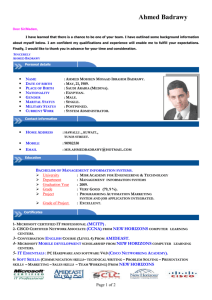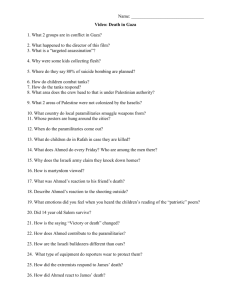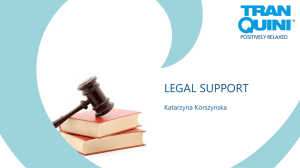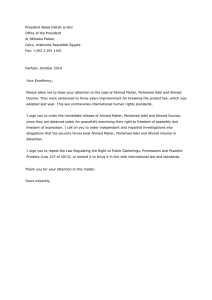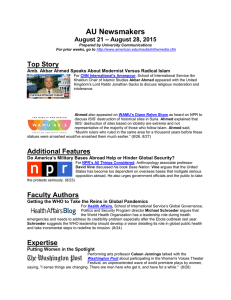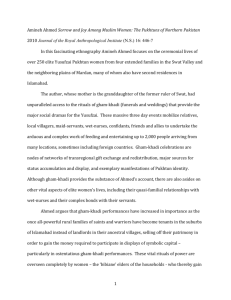ITU Workshop on "E-health services in low-
advertisement
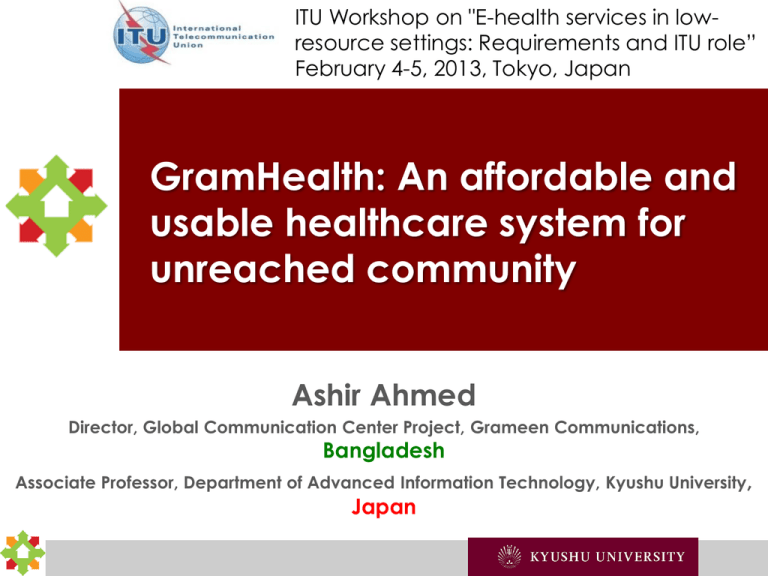
ITU Workshop on "E-health services in lowresource settings: Requirements and ITU role” February 4-5, 2013, Tokyo, Japan GramHealth: An affordable and usable healthcare system for unreached community Ashir Ahmed Director, Global Communication Center Project, Grameen Communications, Bangladesh Associate Professor, Department of Advanced Information Technology, Kyushu University, Japan Agenda GramHealth UnReached People Affordable and Usable Healthcare System Portable Clinic and GramHealth : Experimental Results and Comments © Ashir Ahmed, 2013 (c) Ashir Ahmed, 2012 The Unreached Community The Unreached 3 billion people live on less than $2.50/day 1 billion people unable to read 1.5 million children die of diarrhea each year 1.6 billion people live without electricity ・・・ Category Poverty Education Health Energy ・・・ How can we change these facts? © Ashir Ahmed, 2013 Muhammad Yunus • Was awarded Nobel Peace Prize in 2006. • Contributed to solve poverty issue. © Ashir Ahmed, 2013 Collaboration with Grameen Since 2007 • Development of Technologies based on Social Needs • Social Business to provided social services to the target community in a business way • Healthcare is a focused area of joint-research © Ashir Ahmed, 2013 4 Commonality and Variability Unreached: Beyond the BOP Socio-economic – Low income, Low skills – Compromised infrastructure – Under developed countries 100 M 2 Billion • 4 Billion People BOP • 69% of World Population Natural Disasters – Low/high income, low/ high skills – Compromised infrastructure – Both developed and developing countries Political – Low/High income, Low/high skills – Compromised infrastructure – Both developed and developing countries © Ashir Ahmed, 2013 Charity:Business Reverse Innovation E-Health services in low-resource settings © Ashir Ahmed, 2013 6 Low-resource setting • Doctors don’t want to stay in villages • Quality hospitals don’t sustain without a stable income • Transportation cost is bigger than treatment cost © Ashir Ahmed, 2013 7 Bangladesh case: Health Consultancy over mobile phone since early 2000 CDR GSM Net Patient @Home 1. 2. 3. 4. 5. Doctors @Call Center A patient calls a hotline number. The call is redirected to a call center doctor. The patient-doctor conversation starts. The doctor provides three types of services. The conversation is archived in CDR © Ashir Ahmed, 2013 2-a) Remote Health consultancy over mobile phone Two Case studies 789 Service Tele health 10600 Provider GrameenPhone (a mobile phone operator) JBFH (a hospital) Calls per day 15,000 calls 500 calls Call center doctors 200 doctors / three shifts 10-15 doctors / three shifts Price Free for farmers © Ashir Ahmed, 2013 5 cents per minute 9 Amazing Facts from DoctorPatient conversation analysis Data Source: Tele health 10600 (Case-2) Duration: December, 2009 Total Records: 10000 Selected Records: 400 2-a) Remote Health Consultancy over mobile phone Observed Item (a) Caller 33% patients are females Results (n=400) Patient: 60%, Relatives: → Solves another social40% prolem of female 0-10 years: 29%, 11-20 years: 15% (b) Age distribution of the patient 21-30 years:24%, 31-40 years:17% 41-50 years: 9%, 50+ years: 7 % (c) Sex Male: 67%, Female: 33% (d) Location Rural: 30%, Urban: 70% (e) Call completion Complete: 68%, Incomplete: 32% (f) Time of call Day (8:00-15:30): 57 % Evening (15:30-23:00): 18% Night (23:00-8:00): 25% 17% upphase: (g) Time occupancy of Introduction phase: 8%,follow Diagnosis a single call 27%, Advice phase: 67% patients Disease related: 79%, Preventive healthcare (h) Consultancy about related: 21% →Popular !!! © Ashir Ahmed, 2013 (i) Type of advices Prescribed medicine: 54% , Advice: 28%, Referred to specialist/hospital: 17%, (j) Patients Follow up: 17%, New: 83% (k) Major diseases consulted Gastro-intestinal: 22%, Respiratory: 17%, Reproductive:10%, skin: 10% 10 Advantages and Technical Challenges • Social and Business Aspect • Female patients can stay anonymous for female diseases. Amazing Privacy!! • Access to basic healthcare by millions of unreached patients •Technical Challenges •Bad quality of communications. Incomplete calls. •Doctors cannot see to past records for repeated patients •Doctors can not make a good clinical decision, no diagnostic tools at the patient side to provide health data © Ashir Ahmed, 2013 11 Our response to the technical challenges Portable Clinic Solutions by Portable Clinic (a health check up box) a. Diagnostic tools (one set for one community) b. Broadband Internet (Not GSM) Challenges a. No diagnostic tools b. Bad quality of communications c. No Patient ID management mechanism d. Difficulties to access to past clinical records Solution by GramHealth (a Web based PHR) c. Unique patient ID and Phone number d. Universal access to PHR © Ashir Ahmed, 2013 PHR: Personal Health Record GramHealth 12 Grameen and KU: Towards One Community One Clinic 3,000 USD Affordable? © Ashir Ahmed, 2013 Can we make it more efficient? Portable? Phase 1: System design of a clinic booth using traditional devices and SW tools (a) $3000 “Clinic Booth” with existing devices Rural Patients Patients visit clinic Diagnostic Tools Interface s (d) FHR Urban doctor Viewer (b) FHR Cell Phone (c) FHR Application Server Phase 2: Develop a cost effective portable clinic Proposed $300 “Portable Clinic” Rural Patients Clinic visits patients © Ashir Ahmed, 2013 Affordable ($300?) Portable Clinic © Ashir Ahmed, 2013 The prototype used in field Low cost vs. Accuracy Barcode reader Name cards with barcode Measure (Height, Waist, Hip) Thermo meter Pulse oximeter (Oxygen in blood) Urine tester tape (protein, sugar) Blood sugar meter Blood pressure Buttery Paper and pen Mobile modem Android terminal © Ashir Ahmed, 2013 Weight scale Accuracy of the sensors: Concept of Triage to convince the patient Safe Risky Green Yellow Blood Pressure (mmHg) <140 mmHg <90 mmHg 140≦ <160 mmHg 160≦ 90≦ <100 mmHg 100≦ Blood Sugar <100mg/dl Postprandial Blood Sugar Urine test <140mg/dl Orange Red <180 <110 180≦ 110≦ ≧200mg/d 100≦ <126mg/dl 126≦ < 200mg/dl l ≧300mg/d 140≦ <200mg/dl 200≦ < 300mg/dl l … SpO2 © Ashir Ahmed, 2013 17 ≧96% 93≦ <96% 90≦ <93% <90% © Ashir Ahmed, 2013 18 PHR collection for preventive healthcare Patients’ Advantages: -Access to quality healthcare from home -Saves travel time and cost Health Care Guideline Patients in Village Doctors in Urban Area Triage Internet Triage 1. Registration 2. Health checkup 3. Tele Consultancy 4. Prescription & Suggestion Doctors’ Advantages: -Saves (>70%) doctor-time Can see more patients -Immediate access to health records Better clinical decision © Ashir Ahmed, 2013 19 Portable Clinic in KU-Grameen FHR Internet Lady Health Worker Doctors @Hospital Patient @Home Energy and communication problem Similar to disconnected (due to natural disasters) areas? © Ashir Ahmed, 2013 Nomadic and Portable GramHealth Village-1 Internet Village-2 Village-3 © Ashir Ahmed, 2013 Doctors @Hospital (c) Ashir Ahmed, 2012 GramHealth DB Conversation Data Vital Data Clinical Data Triage 1. Registration 2. Health checkup Triage Health care Guideline 3. Tele Consultanc y Prescription Data BigData in GramHealth 4. Prescription & Suggestion 15,000 records by March, 2013 Collaborator: N. Nakashima, Kyushu University © Ashir Ahmed, 2013 22 4. What’s next? Healthcare BigData? Data Variability and Trends PHR Prescription Conversation GramHealth DBBigData Analysis of BigData will produce Trending -Disease pattern -Geographical distribution -Cohort characteristics Invaluable resource for the Data mining researchers © Ashir Ahmed, 2013 23 Collaboration Opportunities Japan Unmet Needs Joint Experiment Social Problems UnReached People © Ashir Ahmed, 2013 Our Lab Leap frog Technology Projects Technology Developme Prototype nt Business Model Social Business Venture Product Development Research Orgs (Academia, Industry) Local Orgs (NGO, Industries) Developing Countries Can we keep the FHR a the patient side? An Electronic gadget for -MFI (Micro Finance Institution) -FHR (Family Health Record) -Electronic Money Transfer -Future options © Ashir Ahmed, 2013 © Ashir Ahmed, 2013 26 Conclusion Technology to be developed based on the community needs Charity aspect vs. Business aspect Engagement with the local community Role of academia to connect the community and industry © Ashir Ahmed, 2013 27 THANK YOU © Ashir Ahmed, 2013 28
